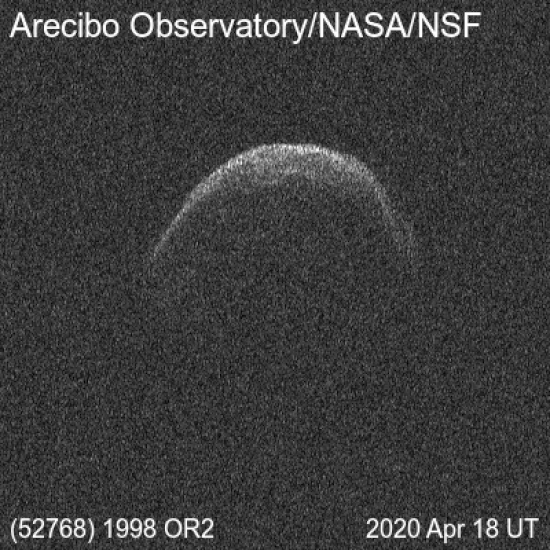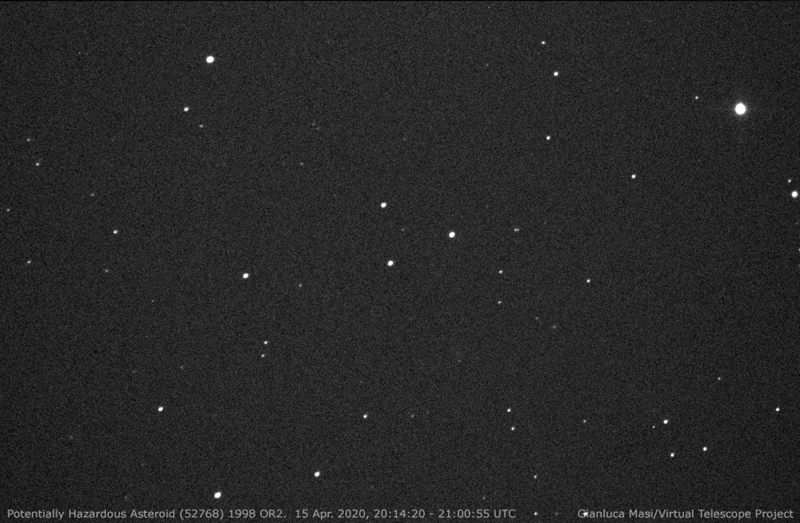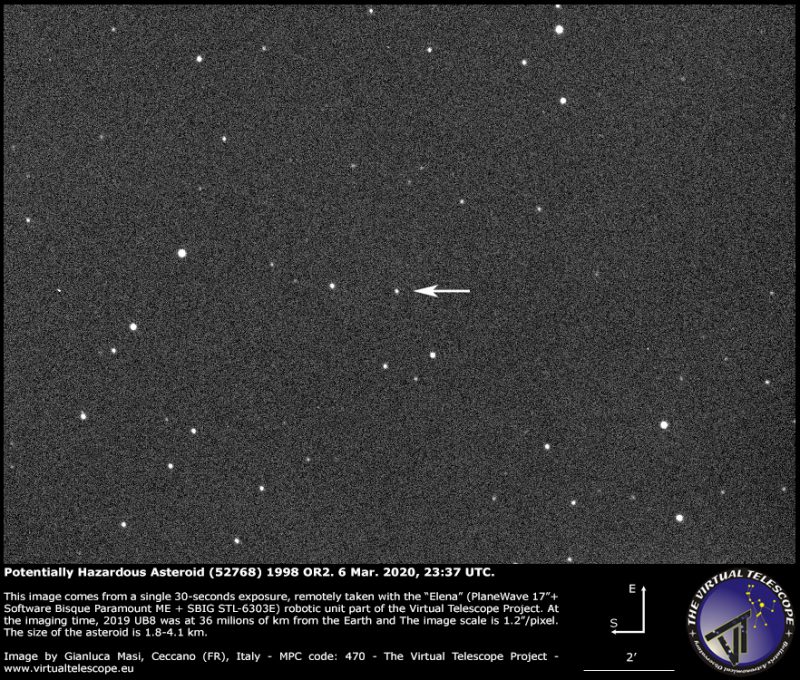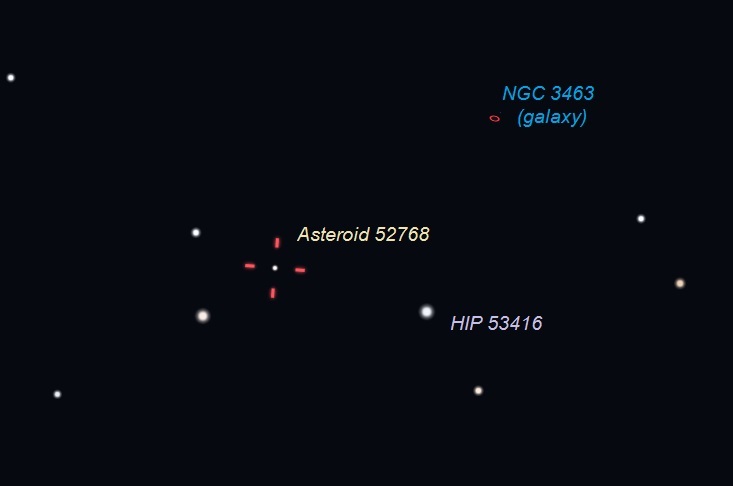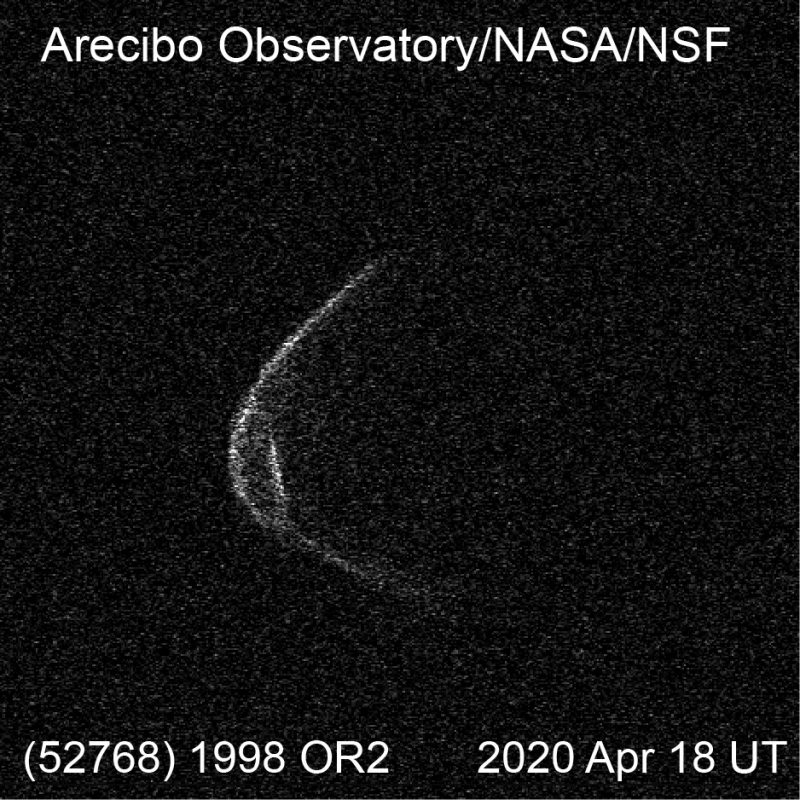A big – very big – asteroid passed relatively close to Earth this morning (April 29, 2020). Asteroid (52768) 1998 OR2 passed at a safe distance, at some 4 million miles (6 million km), or about 16 times the Earth-moon distance. It’s the biggest asteroid to fly by Earth this year (that we know about so far); according to current estimates, it’s probably a bit over a mile wide (2 km) and mostly spherical. Closest approach was April 29 around 4:56 a.m. Central Daylight Time (09:56 UTC). An online viewing of the asteroid from the Virtual Telescope Project in Rome, Italy – originally scheduled for April 28 – has been rescheduled due to clouds last night. The new time for the online viewing is today (April 29, 2020) starting at 1:30 p.m. Central Daylight Time (18:30 UTC; translate UTC to your time).
Professional observatories have been pointing their telescopes at the huge space rock already. Amateur astronomers with smaller telescopes have also been viewing it as a slow-moving “star.” We have a few more charts and tips for observers at the bottom in this post.
Gianluca Masi of the Virtual Telescope Project also acquired 166 images of the asteroid – collected back to back – and assembled them to make the animated gif below. The animation shows you the asteroid’s motion in front of the stars. It was made with images from the Elena robotic unit of the Virtual Telescope Project in Rome, Italy. The asteroid is in the center of the image, visible as a sharp dot of light.
How to see asteroid (52768) 1998 OR2 with a small telescope
Sky enthusiasts can initially use a wide-angle (32mm or 35mm) eyepiece to point the telescope to a reference star in the asteroid’s path (charts below). After being assured that the instrument is pointing at the correct patch of the sky, a 26mm or 27mm eyepiece is recommended to detect the asteroid’s slow motion. You will want to note the star field, and watch for the object that moves over a period of about 10 to 15 minutes. Yes, that’ll be the space rock.
There will be closer approaches of asteroids in the future, including Apophis, which – although smaller – will pass very close to Earth in 2029. Another, larger space rock – 2 miles (3 km) wide – designated as asteroid (415029) 2011 UL21 will pass slightly farther than (52768) 1998 OR2 in June 2024.
But the flyby in April 2020 of asteroid (52768) 1998 OR2 was the most significant close approach of an asteroid until 2027, when another huge asteroid known as (4953) 1990 MU will safely pass by Earth at 12 lunar distances.
Astronomers first discovered asteroid (52768) 1998 OR2 on July 24, 1998, from Haleakala Observatory, Hawaii.
Astronomers at Arecibo Observatory in Puerto Rico studied the asteroid beginning on April 8, as it traveled through space at 19,461 miles per hour (31,320 km/h). The high-resolution radar images at the top of this post and below – from Arecibo – are some of the first glimpses of this large asteroid. In addition to confirming the asteroid’s size (about 2 km [1.25 mi] wide, and mostly spherical), the images uniquely revealed the overall shape of the asteroid and some smaller-scale topographic features, such as hills and ridges. The team of observers working now at Arecibo to observe this asteroid includes astronomers Anne Virkki, Flaviane Venditti, and Sean Marshall from UCF/Arecibo Planetary Group, Dr. Patrick Taylor (remotely) from the Lunar and Planetary Institute in Houston, Texas, and the Arecibo telescope operators Israel Cabrera, Elliot Gonzalez, and Daniel Padilla.
Asteroid 1998 OR2 is classified as a Potentially Hazardous Asteroid. The Center for Near Earth Objects defines such an object as one that comes as close to Earth as:
… 0.05 AU or less [about 19.5 lunar distances] and an absolute magnitude of 22.0 or less …
In other words, such objects are reasonably close and reasonably big. And do we need to say there are a bunch of objects like this? Wikipedia lists 22 of the largest here. Recent decades have revealed more and more asteroids orbiting the sun as shown in this NASA video.
None of the 22 Potentially Hazardous Asteroids listed by Wikipedia is known to be on a collision course with Earth in the foreseeble future. In fact, none of the asteroids in the linked video is known to be on a collision course. Likewise, asteroid (52768) 1998 OR2 isn’t on a collision course with Earth, not anytime soon. The orbit of this asteroid is well known for at least the next 200 years. Its closest approach to Earth in this century and the next will happen in 2079, when it’ll swoop to within about a million miles of Earth (still about four times farther away than the moon). That 2079 sweep past Earth will still be a big deal. Asteroid (52768) 1998 OR2 is the largest known of all large Near-Earth Objects that’ll pass less than five times the Earth-moon distance over the next two centuries!
Bottom line: The huge asteroid known as (52768) 1998 OR2 passed closest to Earth on April 29, 2020. An online viewing originally scheduled for April 28 – and clouded out on that date – has been rescheduled for April 29.



